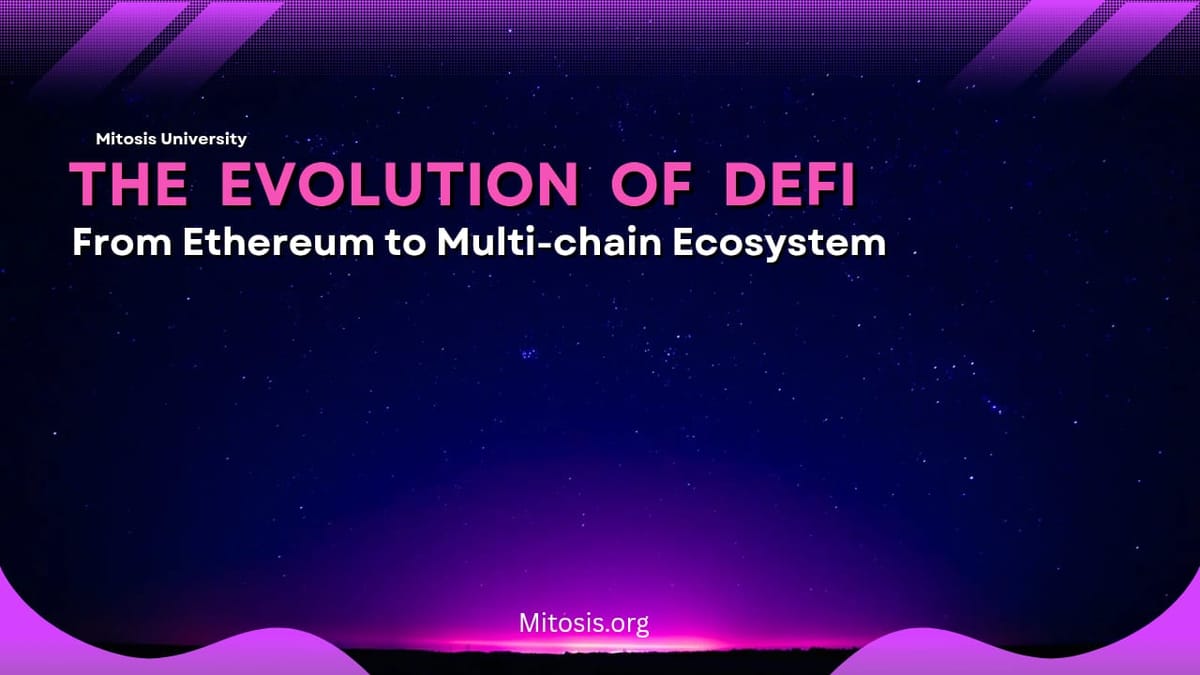The Evolution of DeFi: From Ethereum to Multi-Chain Ecosystems

Introduction
DeFi (Decentralized Finance) started as an experimental idea on Ethereum—a vision of rebuilding financial systems without intermediaries like banks or brokers, using smart contracts and blockchain technology. What began with a few early protocols like MakerDAO and Uniswap quickly evolved into a vibrant ecosystem offering lending, borrowing, trading, and yield farming—all accessible to anyone with an internet connection. However, as DeFi gained traction and user activity surged, Ethereum's scalability limitations became increasingly apparent. High gas fees and network congestion began to price out smaller users and slowed the pace of innovation.
This scalability crisis catalyzed the next phase of DeFi's evolution. Developers and users began exploring Layer 2 solutions like Polygon, Optimism, and Arbitrum for faster and cheaper transactions, while new Layer 1 blockchains like Solana, Avalanche, and BNB Chain emerged with built-in scalability and low fees. These platforms didn’t just replicate Ethereum’s DeFi model—they introduced new architectures, user experiences, and liquidity ecosystems of their own. Today, DeFi is no longer confined to Ethereum. It’s a sprawling, multi-chain universe managing billions of dollars in value, with assets, users, and protocols operating across an interconnected web of blockchains. This expansion marks the beginning of a truly global, inclusive, and interoperable financial system.
This article explores that journey — from Ethereum’s smart contracts to high-speed chains like Solana and Avalanche, and the rise of interoperability through platforms like Cosmos. You’ll learn;
1. Ethereum: The Birthplace of DeFi 2. Scalability Challenges & New Solutions 3. The Rise of Multi-Chain DeFi 4. Composability in the Multi-Chain Era
Ethereum: The Foundation of DeFi
Ethereum, launched in 2015, revolutionized blockchain technology by introducing smart contracts—self-executing programs that run on the blockchain. This innovation laid the groundwork for decentralized finance (DeFi), enabling trustless financial applications without intermediaries. As the first platform to support DeFi at scale, Ethereum became the core infrastructure for a new, open financial system.
Smart Contracts: A Financial Breakthrough
Ethereum introduced smart contracts, unlocking a world where anyone could deploy financial protocols without relying on banks or brokers.
Example: MakerDAO, one of the earliest DeFi projects, used smart contracts to create DAI, a decentralized stablecoin backed by crypto collateral.
The Uniswap Effect and Liquidity Pools
Uniswap changed the game in 2018 with its automated market maker (AMM) model, allowing users to earn yield by providing tokens to liquidity pools — a core concept still used across DeFi today.
Example: A user can provide ETH and USDC to a Uniswap pool and earn a share of the trading fees as passive income.
Scaling Challenges and New Ecosystems
As DeFi adoption surged, Ethereum’s network became congested, leading to high gas fees and slower transaction times. This scalability bottleneck sparked the rise of Layer 2 solutions and alternative Layer 1 blockchains, each offering faster, cheaper environments for DeFi innovation.
High Gas Fees and the Layer 2 Boom
Ethereum’s popularity led to congestion and sky-high fees. In response, Layer 2 solutions like Polygon offered scalable, cost-efficient alternatives, attracting projects like Aave and Curve.
Example: Aave on Polygon allows users to lend and borrow crypto with minimal fees, while Curve offers stablecoin swaps at a fraction of Ethereum’s gas costs.
Solana, Avalanche & the Multi-Chain Expansion
New Layer 1s like Solana, known for its fast finality, and Avalanche, with its customizable subnets, entered the scene promising high throughput, low transaction costs, and a smoother user experience. These platforms quickly gained traction by offering alternatives to Ethereum’s congested network, attracting both developers and users. They launched native DeFi ecosystems like Raydium on Solana and Trader Joe on Avalanche, which provided fast, affordable trading, yield farming, and liquidity provision—offering users fresh opportunities to engage with DeFi in more efficient and accessible ways.
Example: Raydium on Solana provides high-speed token swaps and yield farming, while Trader Joe on Avalanche combines a DEX with lending, staking, and liquidity farming—all with low fees and fast transactions.
Interoperability and the New DeFi Frontier
As DeFi spread across multiple blockchains, the need for seamless communication between them became critical. Interoperability protocols emerged to connect isolated ecosystems, enabling users and assets to move freely across chains—ushering in a new era of cross-chain DeFi.
Cross-Chain Liquidity & Protocols like Cosmos
With Cosmos and its IBC (Inter-Blockchain Communication) protocol, plus tools like LayerZero and Wormhole, DeFi protocols began tapping into cross-chain liquidity, connecting ecosystems once thought isolated. These technologies allow assets and data to move seamlessly between blockchains, enabling a more unified and flexible DeFi experience. As a result, users can interact with multiple chains without needing to leave a single platform, and protocols can access deeper liquidity and broader user bases than ever before.
Example: Osmosis, built on Cosmos, lets users swap assets across IBC-connected chains like Cosmos Hub, Juno, and Secret Network—all from one platform. Similarly, Wormhole enables transferring assets like USDC between Ethereum, Solana, and BNB Chain.
Composability and the Rise of $MITO
Protocols like $MITO are exploring multi-chain composability, enabling users to stake, swap, and yield farm across Ethereum, BNB Chain, and more. This marks a shift toward interoperable DeFi infrastructure, rather than isolated apps.
Example: A user on MITO can deposit liquidity on Ethereum, auto-compound rewards on BNB Chain, and trigger smart contract actions on multiple chains—coordinated from a single interface.
Conclusion
DeFi started on Ethereum, where smart contracts and protocols like Uniswap laid the foundation for a new financial paradigm—open, permissionless, and borderless. However, as demand surged, Ethereum’s limitations became clear, prompting the rise of Layer 2 solutions and alternative Layer 1 blockchains like Solana and Avalanche. These networks brought speed and scalability, helping DeFi evolve beyond the boundaries of a single chain.
Today, the DeFi landscape is undeniably multi-chain. Cross-chain bridges, interoperability protocols like Cosmos IBC and LayerZero, and multi-chain applications are transforming once-fragmented ecosystems into a more unified financial layer of the internet. From the emergence of liquidity pools to the seamless movement of assets and smart contract logic across networks, each phase of development has pushed DeFi toward greater efficiency, accessibility, and global inclusivity. The future of DeFi isn’t just about one blockchain—it’s about many chains working together in harmony.


Comments ()